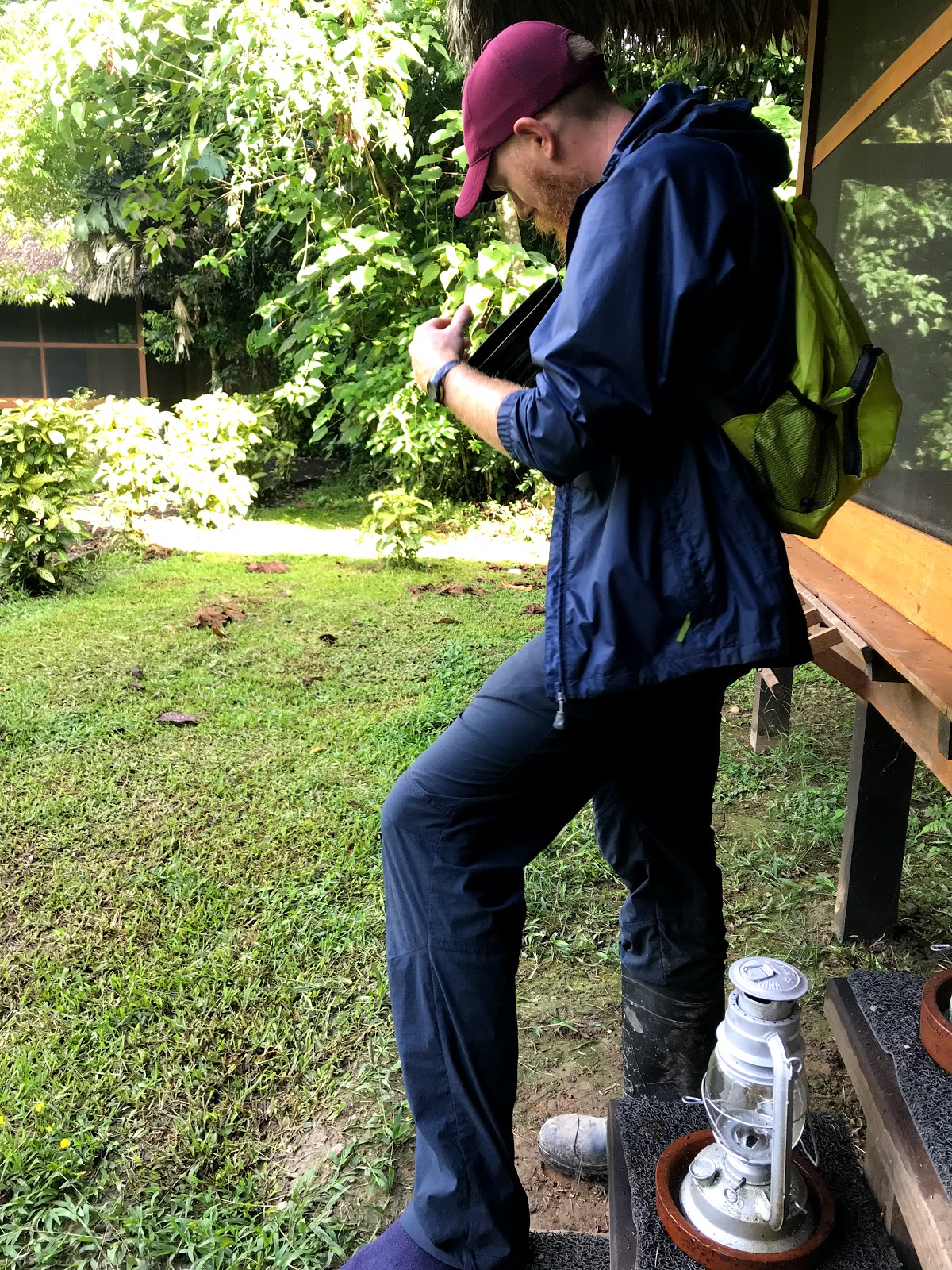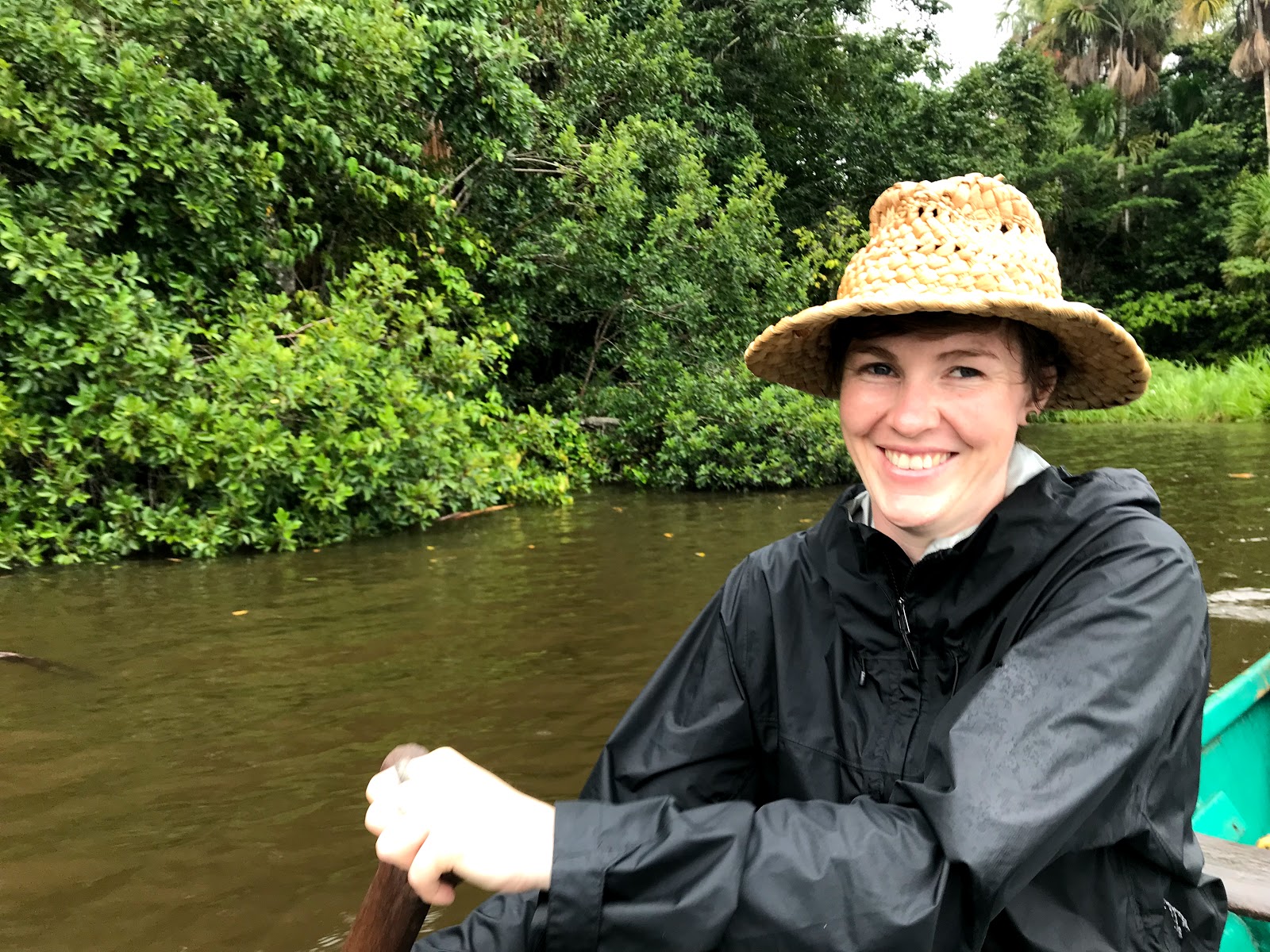"Can you see the tarantula? It's sitting on the branch just above you."
"Don't touch that plant, it is very poisonous."
"Watch when I tap on this Fire Ant Tree, look at all the Fire Ants, don't touch them."
"Look at how beautiful that striped snake is, it is very poisonous."
"Here, eat this small yellow flower. Notice how your entire mouth goes numb? We use that if you have a sore tooth. Oh... don't swallow it! You swallowed it?!"
"If we paddle through the swamp grass over there we may see a large anaconda, they like to rest between the wet grass."
Welcome to the jungle.
Our introduction to the Amazon Jungle was via Puerto Maldonado in Peru. We had a relaxing day exploring the small town and resting in the pool at our accommodation. The town sits between two rivers, the Tambopata and the much larger Madre De Dios.
The following day we met our guides at the port and boarded a small lean motorised canoe to travel downstream to our jungle accommodation at the Inkaterra Field Station. We were warned to prepare for minimal luxuries. Upon meeting our hosts and viewing the rooms, it can only be described as the most refined accommodation we have stayed in so far. We considered it five star luxury with our own beds, tiled bathrooms in beautiful traditional huts nestled in the jungle.
It surprised us all, this was certainly not 'roughing' it. For the next four days our 3 course meals were prepared for us and our own guide, Carmen, organised a variety of excursions to take us on.
Our activities included a walk through the nearby jungle during the day, then later at night. A visit to their own produce farm, they intend to grow everything required for their meals. A look at their palm plantation, an aim to also grow all of their own wood and materials required for maintenance of their buildings.
We took a boat tour across to a small island and walked the island observing various animals and vegetation. Another tour to Lake Sandoval, which was within the National Reserve. We canoed around the lake looking at all of the bird life, monkeys and creatures on the banks.
A lovely stroll through the canopy of jungle trees on swing bridges. As well as a few moments resting peacefully in our huts listening to the sounds of the jungle.
We considered ourselves fortunate, we visited in their quiet season, the wet season. This meant we only saw one other tourist couple on our first day, then we had the place to ourselves as tourists until another couple arrived on our last evening. The rest of the people were either staff or researchers.
The station, as well as taking tourists, also acted as a research center for a variety of scientists and researchers. There were a group studying butterfly's and an ornithologist we made friends with from Colorado named Alec.
Alec had installed some microphones around the station and was working with a particular type of software to attempt to understand the effects of land clearing on bird migratory patterns and movements. A more efficient method of tracking birds than purely observing them. Most days though, we found him in the open garden area with his binoculars aimed high and his head tilted back watching hundreds of different species fly overhead and taking notes. It was a joy to meet such a young person who was so passionate about his work.
Another treat at the station was our chef, Roberto. His English was excellent and we loved the time he gave us to talk through each of his dishes, the ingredients and how he put them together. He loved his food and was now teaching other chefs at the station how to cook. In five years he hoped to return to Lima and set up his own restaurant with his family.
Learning from Roberto, we were amazed the variety of ingredients he used from the jungle garden. Jungle potatoes, jungle basil, jungle cilantro, jungle cucumbers, jungle tomatoes..We're sure there were also native names for these! Every meal was delicious and it gave us the strength we needed for the jungle trekking.
We surely would have perished in the jungle if it were not for our amazing guide, Carmen. She loved being a guide as it provided her many opportunities to visit many parts of the jungle. Her English was excellent, her German even better. Many years ago, to increase her opportunities, she taught herself German. Then travelled to Germany for 6 months to improve her understanding. She now takes all of the German tour groups when they come through Puerto Maldonado.
On each adventure, she would lead us down the jungle trails and stop to highlight all the interesting things taking place. Her knowledge of the plant and animal life was incredible, as well as the local history and transformation taking place in the Amazon through farming and land clearing.
To us, her eyesight was better than a telescope as she picked out the most obscure detail for us to focus on.
"At two o'clock, can everyone see the bats?.... The bats, on the tree at two o'clock, three metres from the ground.... It is the grey tree leaning to the left ahead of us... there are two bats sleeping on the trunk of the tree.... Can you see them?. .... Now two thirty, 23 metres ahead of us, three metres from the ground, below the bright green palms, two grey bats against the trunk. There we go, everyone see them now? Good."
"At two o'clock, can everyone see the bats?.... The bats, on the tree at two o'clock, three metres from the ground.... It is the grey tree leaning to the left ahead of us... there are two bats sleeping on the trunk of the tree.... Can you see them?. .... Now two thirty, 23 metres ahead of us, three metres from the ground, below the bright green palms, two grey bats against the trunk. There we go, everyone see them now? Good."
We felt sorry we made it so hard for her. Though her eyesight was incredible.
Only once on an excursion did we find ourselves in heavy rainfall. We came prepared and kept the important things dry. For the most part the weather was considerably pleasant, 30 degrees with about 80% humidity. If the sun was shining it was hot, otherwise the clouds would keep us cool and most evenings a cool breeze came through. We slept like logs and felt safe and secure in our fly netted huts and fly net beds.
We had one surprise visitor, which happened on our first morning. We were provided gumboots for our excursions as most of the paths were heavy with mud. We kept these inside our fly netted huts and thought everything should be secure. Those who grew up on a farm, knew to check their boots before putting them on. For some reason, Ian forgot to. He slid his feet into the gumboots and felt his right one a little cramped.
He convinced himself that it was just his sock that had become a little scrunched up at the end. Everyone made their way over to the work hut to meet Carmen and prepare for our trip. Carmen provided some insight for our adventure and showed us a variety of different books and pictures of the jungle animals so we knew what to look out for. As we made our way out of the work hut to start our trek, Ian thought he might just re-adjust his sock. He slipped off his right gumboot and a large brown frog dropped out.
The frog was a little startled and hopped towards a laughing Jacqui. The end of Ian's sock was slimy with frog sweat. He decided it was a good time to also check the other boot just to make sure.
Ian now checks every shoe before putting it on.
The gumboots were a key necessity in most of our walks, none more so than our 3km hike to Lake Sandoval. Some heavy rain had come down before we arrived and the path was a child's playground for mud splashing. Carmen weaved in and out of the trees on the edge, small enough to duck and squeeze when needed. Jamie and Ian took the 4wd route up through the middle with many risky moments as the foot sunk deeper than they expected. While Jacqui and Alex attempted the intelligent snake like weaving of high ground, a slower path but drier.
At our final evening, we talked through our favourite moments. We couldn't decide on just one.
The time when Carmen poked a stick down the hole of tarantula nest, our frightened surprise when the tarantula launched out to defend its home. We asked if Carmen could please choose a longer stick.
The time when Carmen poked a stick down the hole of tarantula nest, our frightened surprise when the tarantula launched out to defend its home. We asked if Carmen could please choose a longer stick.
Sitting in the canoe on the edge of Lake Sandoval as a family of Squirrel Monkey's ran and jumped across the trees only a few metres away.
Learning of the background and unique character of 'Stinky Birds'. Beautifully ugly chicken type birds always in pairs as they wheeze an asthmatic like breath.
Freezing in motion while a lime green snake slithers through the leaves on the path in front of us.
Or slowly peering forward as Carmen tells us to be still while she points to a delicate translucent butterfly poised on a flower in front of us.
Of all we experienced, it was clear to us all, this jungle was full of life. From the canopies to the ground, the vegetation and the animals, everything trying to survive.
On our fourth day we returned to Puerto Maldonado, we visited a small butterfly house and saw many of the same that had been in the wild.
We made it to our accommodation for a further two nights, an ecovillage on the outskirts of town. Here we would rest and enjoy our last days. Swatting mosqitoes, flicking away spiders and attempting to relocate frogs from our beds.
Inkaterra you surprised us all, with your luxury and comfort. A special treat we will never forget. Thank you to Roberto and Carmen for making our stay remarkable.





























































You have truly captured this experience in words and images.... so fortunate you are...
ReplyDeleteThanks for opening our eyes to the majesty of the Amazon from afar.
ReplyDelete